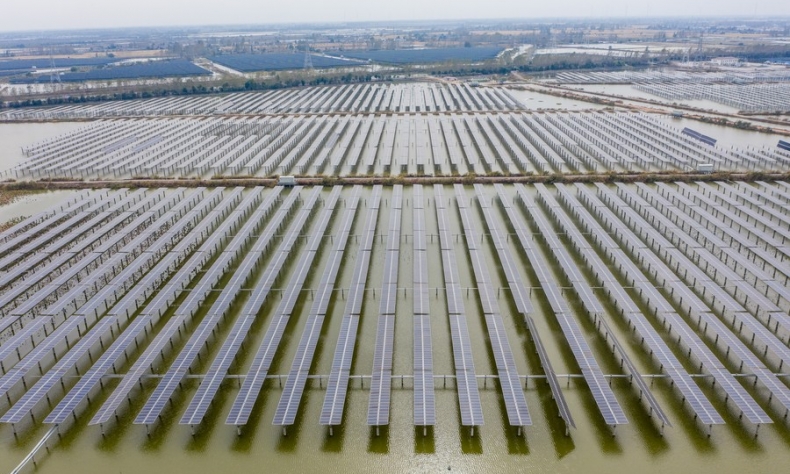China’s Climate Ambitions and Actions Set an Example for the Rest of the World

Beijing’s ambitions and actions provide a new paradigm for the world in its battle to contain the climate crisis.
National determined contributions (NDCs), countries’ commitments to address climate change, are at the heart of the Paris Agreement signed in 2015. To achieve the target of keeping warming by “well below 2 degrees Celsius” compared to pre-industrial revolution years, global greenhouse CO2 emissions need to be cut world wide in half by 2030 and reach net-zero, or carbon neutrality, by around 2050.
According to the landmark climate pact, each country should implement its NDCs that they submitted from 2020 and update their targets before year-end. Up to now, more than 70 countries have submitted new NDCs, among which about 30 countries have set targets for carbon neutrality, net-zero emissions or so called climate neutrality through laws and/or edicts. Among others, China’s climate ambitions and decarbonization efforts have impressed the world.
An example for developing countries
In June 2015, China submitted its carbon-curbing plan to the United Nations Framework Convention on Climate Change (UNFCCC). At the Paris climate change summit that same year, China announced its NDCs, pledging to cap its carbon emissions around 2030 and work hard to peak earlier.
In September 2020, President Xi Jinping announced in a speech at the UN General Assembly (UNGA) that China would strive to reach peak emissions before 2030 and achieve carbon neutrality by 2060.
During the Climate Ambition Summit in mid-December 2020 President Xi further announced that by 2030, China would reduce its carbon intensity by 65 percent from 2005 levels, and raise the share of non-fossil fuels in primary energy consumption to 25 percent. President Xi confirmed also to increase forest stock by 6 billion cubic meters above 2005 levels and bring the total installed capacity of wind and solar photovoltaics (PV) to over 1,200 gigawatts (GW) by 2030.
Amid the pressing climate crisis, the largest developing country’s promise to peak carbon emissions and reach carbon neutrality is a profound commitment. “This major strategic decision is made based on our sense of responsibility to build a community with a shared future for mankind and our own need to secure sustainable development,” said President Xi at the Leaders Summit on Climate.
Beijing’s pledges underscore that China is shouldering its responsibility as a major country and is proactively implementing the Paris Agreement.
“Brown to Green” revolution
In order to achieve its self-set climate goals, China needs to cut more carbon emissions in a shorter time span than even developed economies.
Nevertheless, to reach carbon peak and neutral is a must for high-quality development. As President Xi stated in his address to the ninth meeting of the Central Financial and Economic Affairs Commission, to achieve our targets would amount to a profound systematic economic and social revolution. Indeed, China’s ambitious target entails challenges to the economic structure, industrial infrastructure, consumption habits, and the energy mix.
To attain carbon neutrality requires a change in the way of thinking and an all-around “Brown to Green” revolution. While China’s detailed action plan for peak carbon emissions by 2030 is still expected later this year, China has made it clear that it will integrate the concepts of carbon peak and neutrality into the whole framework of environmental protection and encourage local governments, key industries and enterprises in favorable conditions to cap their carbon emissions even earlier. To cut carbon emissions to net zero by 2060, China has to take actions step by step, dividing the length into four ten-year phases and eight five-year plans.
Leading global climate actions
In an ever-changing world, China’s climate ambitions and actions are the anchor of the global response to climate change. Building upon the international consensus in tackling climate crisis, China is spearheading climate actions to help build a fair and equitable system of global environmental governance for win-win cooperation, making China a proactive participant, contributor and trailblazer in global ecological conservation.
Climate change is a common challenge facing mankind, and no country can be immune to the climate crisis. All climate summits are supposed to further empower the Paris Agreement. The video summit between China, France and Germany on April 16, 2021, and the Leaders Summit on Climate on April 22, 2021, are both aimed at translating the Paris Agreement into actions through the COP26 conference in Glasgow later this year.
The principle of common but differentiated responsibilities is the cornerstone of global climate governance. In addition to pledging more climate ambitions and actions, developed countries should make concrete efforts to help developing countries strengthen their capacity and resilience against climate change. They should support them in matters of financing, technology, and infrastructure building, and refrain from creating green trade barriers.
As the global leader in renewable energy production, development, and deployment, China is already assisting in this endeavor. Through its vast network of industrial supply chains, China continues to make significant contributions to the world’s green energy revolution and global climate governance.
Beijing’s ambitions and actions provide a new paradigm for the world in its battle to contain the climate crisis. As President Xi said at the Leaders Climate Summit, “Faced with unprecedented challenges in global environmental governance, the international community needs to come up with unprecedented ambition and action. We need to act with a sense of responsibility and unity, and work together to foster a community of life for man and Nature.”
Dr. Tang Xu is a professor at Fudan Development Institute(FDDI) and Deaprtment of Atmospherc and Oceanic Sciences / Institute of Atmospheric Sciences (AOS/ASI) executive director of IRDR International Center of Excellence (ICoE) under Fudan University on Risk Interconnectivity and Governance on Weather/Climate Extremes Impact and Public Health”(ICoE-RIG-WECEIPHE), and former director of Weather and Disaster Risk Reduction Services Deaprtment(WDS), World Meteorological Organization (WMO).
Translated by Liu Xiaomin
Copyedited by Jamie Leigh Wright
 Facebook
Facebook
 Twitter
Twitter
 Linkedin
Linkedin
 Google +
Google +










